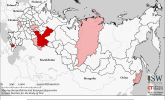Russian Offensive Campaign Assessment, July 22
July 22, 2022 - ISW Press
The United States announced a new $270 million security package for Ukraine, and Ukrainian officials detailed their procedures for keeping track of Western weapons on July 22.[1] The US package includes an additional four high mobility artillery rocket systems (HIMARS), 36,000 artillery ammunition rounds, anti-armor systems, and 580 Phoenix Ghost drones.[2] Ukraine’s National Security and Defense Council Secretary Oleksii Danilov reiterated that the Ukrainian government is employing multiple monitoring mechanisms to keep track of weapons deliveries to Ukraine.[3] Ukraine’s Modern Information and Analytical System of the Main Situational Center (COTA) reportedly allows Ukrainian officials to monitor the status of arms deliveries to Ukrainian frontlines and works in tandem with NATO’s LOGFAS logistics and accounting control system.[4] Danilov’s statement is likely a response to an ongoing Russian information operation that seeks to discount Ukraine as a trustworthy recipient of Western military aid.[5]









